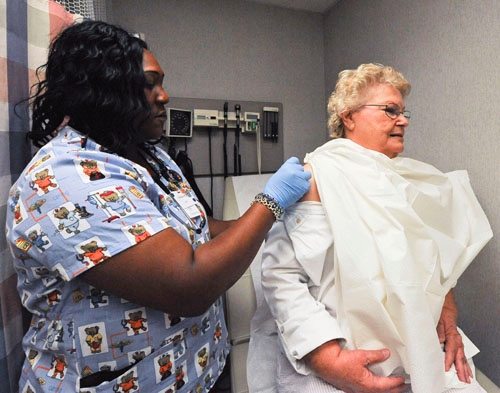Vaccinations can prevent potentially deadly flu, but some in Las Vegas skip shots


A quiz: How many Americans got flu shots last year?
In making a guess, remember that flu season arrives each and every year, that getting a flu shot has become as convenient as picking up a quart of milk, and that deaths related to influenza in the United States number in the thousands each year.
So: How many Americans got flu shots last year?
The answer: less than half.
Which leads to another question: What’s up with that?
Consider Wilma Davis among the flu shot faithful. Davis, 75, got her seasonal flu shot last week at Southwest Medical Associates’ North Tenaya Way clinic, but she admits she wasn’t always so conscientious about doing so.
In fact, Davis got her first flu shot in 2001. Then, she recalls, "I got the flu."
"It was my first time, and I got really sick on it," Davis says, smiling. "I got the flu really bad, and I said, ‘I’m never going to do this again.’ "
But a few years later, she gave it another shot.
"I’ve gotten it every year since then," Davis says, and – knock on wood – hasn’t had the flu since.
Davis’ trip to the doctor’s office was perfectly timed. Although there’s no official start to the flu season, Dr. David Park, chairman of the primary care department at Touro University Nevada College of Osteopathic Medicine, says flu season typically starts in October and runs through about May.
This year’s formulation of seasonal flu vaccine – which is intended to protect patients against the flu strains experts consider most likely to circulate over the next several months – already has arrived at many area doctors’ offices. But if recent history means anything, most of us won’t bother to make use of it.
It’s easy to forget how serious seasonal influenza can be. For most of us, a bout of flu means feeling miserable for a week or so and getting back on with our lives. But every year, says Brian Labus, senior epidemiologist for the Southern Nevada Health District, "people end up in the hospital and even die from influenza."
According to the federal Centers for Disease Control and Prevention, influenza is associated with as many as 49,000 deaths each year in the U.S., and an average of more than 200,000 hospitalizations annually. Most flu-related fatalities are infants, people older than 65 and those whose immune systems aren’t, for whatever reason, strong enough to fight off the virus and the serious medical conditions – most notably, pneumonia – that can follow from being infected with it.
Yet, despite all of this – and even the simple garden-variety misery the flu brings to otherwise healthy people – the CDC estimates that only about 46 percent of Americans ages 6 months and older were vaccinated during the 2011-2012 flu season.
Labus notes that, throughout the U.S., state-by-state flu vaccination rates last season ranged from about 40 to 60 percent. And Nevada? "We were about 37 percent last year, plus or minus," he says.
"In general, it is still a challenge in a lot of groups to get them to understand the importance of flu vaccination," Labus says. "It’s a challenge to get that message out that it’s a safe vaccine, it’s an effective vaccine and it will keep you from getting the flu."
"As a physician, I get so frustrated," says Dr. Linda Johnson of Southwest Medical Associates. "In my mind, this is such a simple way to protect yourself, why wouldn’t everybody do it?"
Maybe it has something to do with where we live.
"It’s still so warm," Johnson says. "It’s still 100 degrees here, and people are not thinking about the flu season."
Maybe it has something to do with procrastination.
People, Johnson says, may figure that the flu season starts in October, so there’s still time to get it done.
Maybe it has something to do with complacency.
People can be "very cavalier" about influenza, says Dr. Beverly Neyland, professor of pediatrics at the University of Nevada School of Medicine.
"We’ve not had a really bad epidemic," Neyland says, "and I think people are depending on that continually to happen, so they’re not protecting themselves because of that."
Maybe it has something to do with the cost of flu shots.
Although they’re covered by most medical plans and by Medicare, a flu shot can cost $25 and up. So, faced with a triple-digit tab for vaccinating an entire family, a parent may take a "calculated risk" to forgo shots and hope for the best, Park says.
Maybe it has something to do with thinking that a flu shot isn’t really necessary.
"I get that comment all the time: ‘Oh, I’ve never gotten the flu before, I don’t need that,’ " Johnson says.
But the main reason, Park says, is "they’re afraid it’s going to cause them to get the flu, or they’ve had an experience in the past where they got a vaccination and developed a mild fever or body ache and think they got (an) infection from the shot."
However, the injectable flu vaccine used today – the most widely used form of the flu vaccine – is not made from an active virus. So, Park says, a flu shot can’t give someone a case of the flu.
However, Park continues, as the body makes antibodies in response to the flu vaccine’s inactivated virus – that’s how the vaccine works – "sometimes you can feel slightly feverish and slightly tired."
The reaction won’t feel anything like a bout of actual flu, Park says. But that mild reaction over the 24 hours or so following a shot may dissuade patients from ever getting another flu shot.
Note, too, that the flu vaccine can take about two weeks to help the body do what it needs to do. So, it’s possible that the symptoms somebody gets after receiving a flu shot is the result not of the vaccination, but of exposure to an infected person before getting the shot.
The CDC recommends that every American older than 6 months receive a seasonal flu shot. Among those who are particularly urged to get flu vaccinations each year are older people, people with diabetes or other conditions that can compromise the immune system, pregnant women, and people with asthma, emphysema, chronic bronchitis and other lung and respiratory illnesses.
Neyland says children younger than 2 also are "quite vulnerable" to the flu because their immune systems are not yet fully developed. For maximum protection, every member of a family, including the child, should receive flu shots each year.
Then, as with adults, "children you really want to get immunized are kids that have chronic disorders – asthma, diabetes, any kind of neuromuscular disorder, any type of congenital heart disease," Neyland adds. "Those kids, you need to make sure they’re protected because they don’t tolerate any type of viral or bacterial infection well."
For those who aren’t fond of needles – another reason patients give for not getting flu shots, Park says – an inhalable flu vaccine now is available. However, unlike the injectable vaccine, the inhalable version is made from a weakened live virus and is licensed only for people ages 2 through 49.
Both types of vaccine provide the same protection, Labus adds, but the injectable version can be used with a wider group of people.
By the way: If you do end up getting sick, don’t be so quick to blame the flu.
Generally speaking – and your own physician will offer the final word on this – the flu tends to be associated with body aches and fever. If you don’t have those, you’ve probably just got a bad cold.
"The major difference is, the flu is more of a systemic illness," Park says. "So a high fever and body aches are characteristic of flu."
Also, Park says, "typically, a cold stays with the head and maybe the upper part of the chest and throat, so you get more of a runny nose and stuffy nose and sore throat and some mild coughing."
In children, however, flu symptoms "may be kind of vague," Neyland says. They might have a fever, or might have diarrhea or vomiting, and the symptoms "can be a coming-and-going type of thing."
Either way, contact your pediatrician if you’re concerned or if symptoms worsen. And whether you get a shot or not, if you do get the flu, stay home.
Antiviral medications can lessen the severity of the flu and cut a few days off of its duration. But, Park says, the medications need to be administered within the first 48 hours of onset and, ideally, within the first 24.
Ultimately, Johnson says, "the main thing is rest. You need to stay home and take care of it."
Contact reporter John Przybys at jprzybys@reviewjournal.com or 702-383-0280.
WHEN TO SEE A DOCTORShould I stop self-treatment and seek medical care?
Usually, people with the flu can tough it out with self-treatment (taking Tylenol or Advil for fever, and over-the-counter cough medicines or decongestants) until the virus runs its course.
But it can be difficult to know when it’s time to stop self-treating and seek professional medical help. Here, from the Southern Nevada Health District, are symptoms that would merit seeking medical care at an urgent care center (the first choice of treatment) or (if necessary) an emergency room.
For children
• Fast breathing or difficulty breathing
• Bluish or gray skin color (call 911 immediately)
• Not drinking enough fluids
• Severe or persistent vomiting
• Not waking up or not interacting
• Being so irritable that the child doesn’t want to be held
• Flulike symptoms improve but then return with fever and worse cough
For adults
• Difficulty breathing or shortness of breath
• Pain or pressure in the chest or abdomen
• Sudden dizziness
• Confusion
• Severe or persistent vomiting
• Flulike symptoms improve but then return with fever and worse cough
FLU ADVICE
The Southern Nevada Health District and area physicians offer a few things to remember during flu season.
If you haven’t gotten a flu shot, get one. Getting a shot now will prepare you for the impending start of the flu season and leave you protected until it ends.
If you do get the flu, you may be ill for a week or longer. Unless you need to leave the house to seek medical care, remain at home and drink plenty of fluids to avoid dehydration.
Wash your hands frequently with soap and warm water or use a hand sanitizer.
Cover your coughs with a tissue or your sleeve.
Avoid contact with other people as much as possible so as to not spread your illness. Particularly avoid contact with persons who may be at higher risk for flu-related complications (including children younger than 5 and particularly younger than 2; adults 65 and older; pregnant women; and people with chronic lung or respiratory conditions including asthma, heart problems, neuromuscular conditions or diabetes).
If you’re in a high-risk group, consult your physician. Also call a health care provider if you’re not sure whether you need to seek medical attention or if your symptoms worsen.
If you do leave the house to seek medical care, wear a face mask.
Don’t return to work until your fever has been gone for at least 24 hours without the aid of fever-reducing medications (Tylenol or Advil, for example).


















